The AMD Kabini Review: A4-5000 APU Tested
by Jarred Walton on May 23, 2013 12:00 AM ESTKabini Windows 8 Laptop Performance
With the SoC and “lighter device” benchmarks out of the way, let’s also look at what Kabini offers for a full laptop experience. Let me preface this section by simply stating many of our laptop benchmarks really aren’t a good fit for an APU like Kabini—e.g. doing 3D rendering or x264 HD encoding on such a chip is just asking for poor performance. We’re also looking at different OS configurations (Windows 7 vs. Windows 8, IE8/9 vs. IE10), so there’s a slightly higher potential for margin of error here.
Our current list of laptops includes AMD's Brazos E-350 (MSI X370), Kabini A4-5000, and Trinity A10-4600M; on the Intel front we have i7-3517U (Dell XPS 12) and Pentium 2020M (a late addition when we managed to get a laptop for short-term testing). Both of the Intel chips are 22nm parts, but note that the Pentium chip is a 35W part. Sadly, we have not yet been able to get a Pentium 2117U as a comparison. [Note: Some laptops are still being tested on some of the benchmarks; their scores will be added/updated as they complete.]
We do want to see what sort of gains are present relative to Brazos, however, so let’s get started. We’re presenting an abbreviated look at performance here, but we have the full set of benchmark results in Mobile Bench, including some of our older benchmarks that we’ve run against Brazos and other laptops prior to 2013. There are two main questions to consider for each benchmark: how much faster is Kabini than Brazos (and where does it place relative to other options), and does Kabini provide enough performance to handle the task represented by the benchmark?
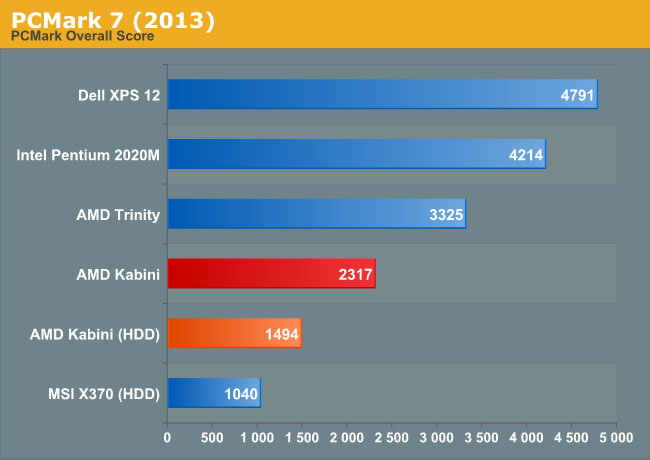
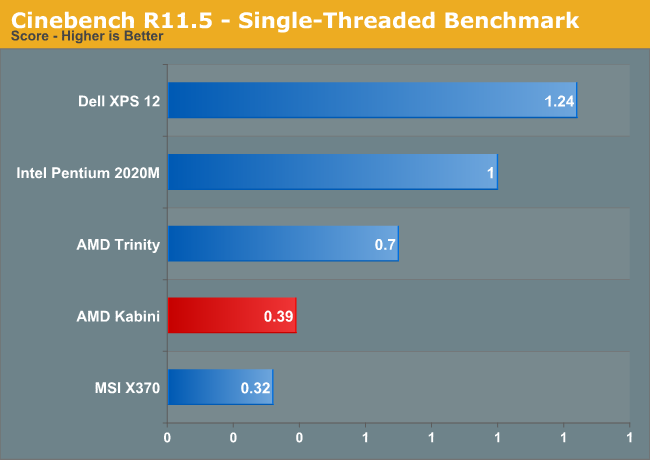
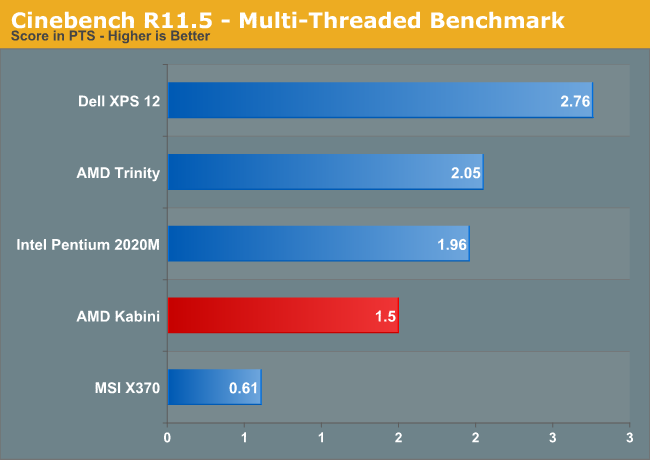
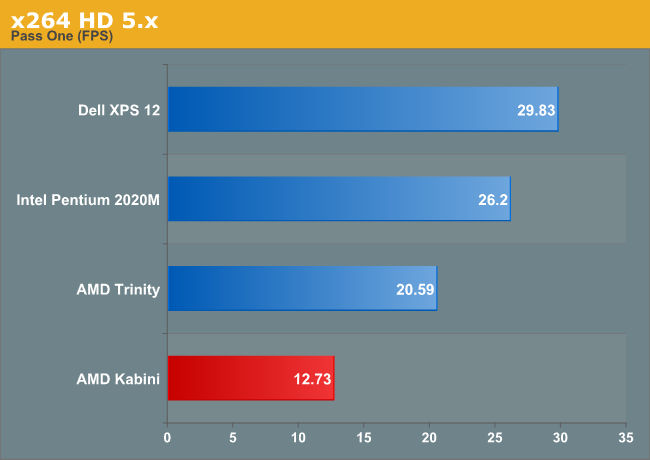
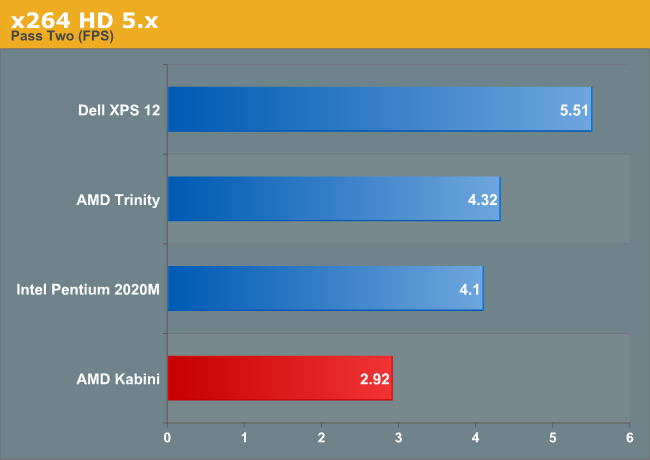
Starting with PCMark 7, we have both HDD and SSD results. As usual, the presence of an SSD boosts performance in the overall score by more than 50%, so Kabini with an SSD can feel far more responsive than Ivy Bridge with an HDD, depending on the task. Relative to Brazos, even with an HDD on both laptops, Kabini is nearly 50% faster. ULV Ivy Bridge on the other hand offers twice the performance of Kabini in the overall score, though Quick Sync skews that pretty heavily. Looking at the individual results, ULV IVB is around 30-50% faster on most CPU tasks, and it’s even a bit faster on the GPU side in most areas as we’ll see in a moment.
Update: We've added Pentium 2020M to the above charts, which lacks Quick Sync support and runs at a maximum clock speed of 1.8GHz. It's clearly slower than the i7-3517U in the Dell XPS 12, but it's also still a healthy step up from Kabini in terms of performance. The 2020M is a full 35W part, like the A10-4600M, and it tends to slightly outperform Trinity on CPU tasks while trailing in GPU performance. On the Kabini front, however, even the Pentium 2020M is able to lead on nearly all the performance metrics.
The CPU performance testing of x264 HD 5.x and Cinebench confirm the CPU deficit AMD faces with Kabini. In heavily threaded workloads, Ivy Bridge ULV is 50-100% faster, but the real problem is in the single-threaded workloads. A single Jaguar core in Cinebench manages to score just 0.39 compared to IVB ULV’s score of 1.24, so worst-case Kabini is one third the speed of Ivy Bridge. Standard Voltage Trinity APUs are likewise a big step up from Kabini, offering roughly twice the CPU performance in some cases. Of course, the power draw from standard Trinity tends to be far higher than Kabini.

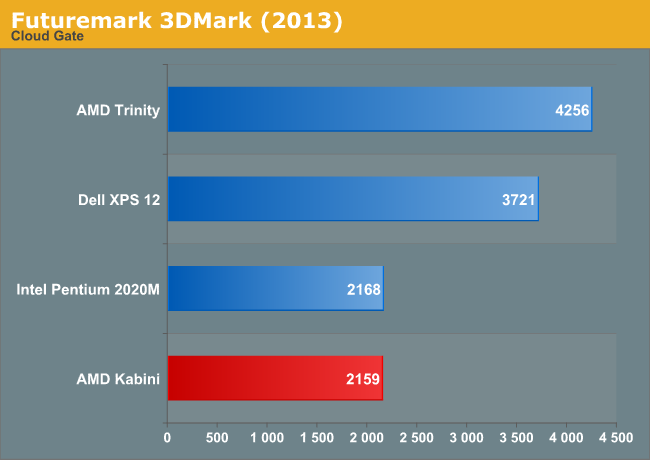
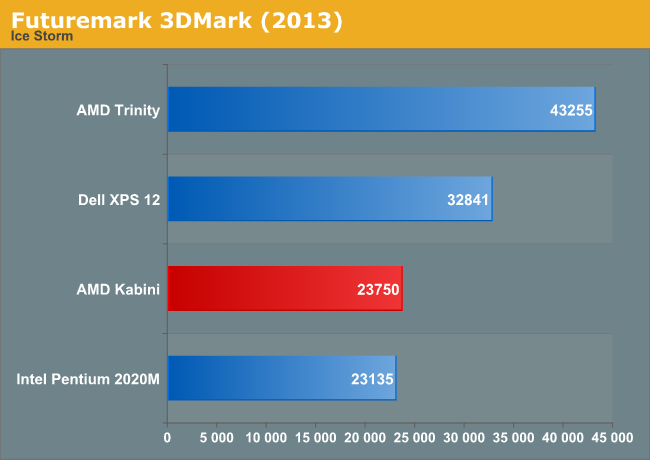
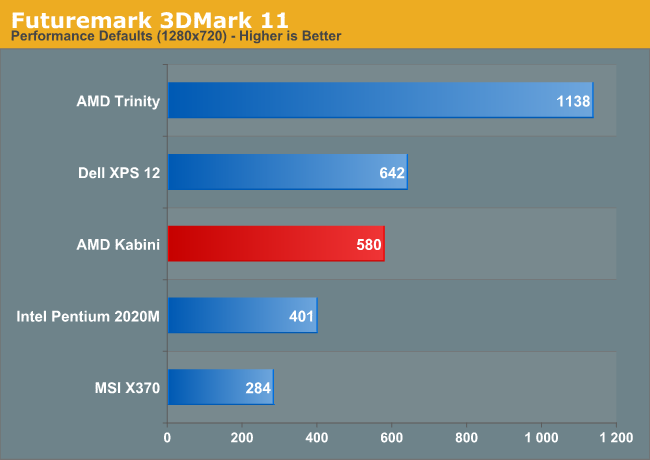
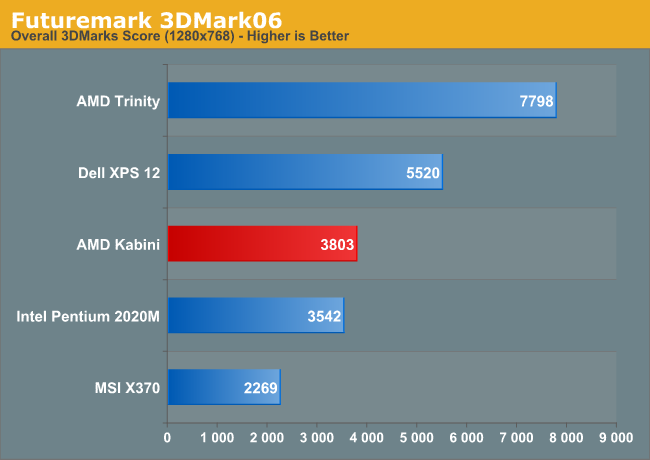
Quickly looking at the 3DMark results, if you were hoping Kabini would be fast enough to handle modern games at moderate detail settings, the relative standings in 3DMark should help prep you for what’s to come. The A10 Trinity can handle many titles at moderate details, but even it struggles with many of the latest releases; Kabini has about a third of the total GPU compute performance of Trinity, and while it’s a bit faster than that in some games, for the most part it’s best suited for older games that don’t require as much from the CPU or GPU.
As for Intel's chips, while the Core i7 ULV part ends up faster than Kabini, the same can't be said of the Pentium 2020M; it's a tie in some tests but falls behind (sometimes significantly, e.g. 3DMark 11) in others. As neither chip is really fit for high-end graphics work, it's not really a major concern. If you want decent graphics performance, you're going to want more than either Kabini or Ivy Bridge has to offer.










130 Comments
View All Comments
Kevin G - Thursday, May 23, 2013 - link
Those aren't real benchmarks, just estimates that are based upon improvements from an anonymous source.TerdFerguson - Thursday, May 23, 2013 - link
It should be criminal to market any of these chips as "Elite Performance" platforms. The words elite and performance have pretty well understood meanings, which nothing AMD is offering stand up to. If I'm shopping for a new computer and it is advertised as an elite performance platform, I'm going to expect it to run AAA games at elite settings.AMD is distancing themselves from my wallet a little more every day, thanks to weak products, weak initiatives, hype and terribly dishonest marketing.
Finally - Thursday, May 23, 2013 - link
I want a Kabini in my Office PC, I want one in my 13' laptop and I surely will be recommending them to all my friends.lmcd - Thursday, May 23, 2013 - link
Don't know about in your office PC unless you're an Office-only type of worker. I guess that applies to a lot, but I wouldn't know. I could see it in an AIO for office type of deal, or nice, SFF setups. I feel like multi-seat and/or thin-client setups would be cheaper though. May as well buy that i3 if you're getting an independent machine.wumpus - Saturday, May 25, 2013 - link
Considering just how many office machines are running XP (the pentium4s only get replaced when they burn up, the core-based products are likely to stay until the IT department adopts some faddish idiocy*).* not saying that core+windows is irreplaceable, just that stupid business fads are much more likely than real reasons to replace them, the money being available, and enough pointy haired bosses on board at the same time.
kyuu - Thursday, May 23, 2013 - link
Uh huh, I'm sure you were totally predisposed toward getting an AMD product until you saw that marketing-speak.Dude, it's marketing. Intel is just as (if not more guilty) of the same. Feel free to hate marketing-speak -- I certainly do. But let's not pretend it's something unique to AMD, m'kay?
And uh, there's nothing weak about Jaguar, from what I can see. It looks like the best low-power x86 SoC bar by a large measure.
kyuu - Thursday, May 23, 2013 - link
It looks like the best low-power x86 SoC by a large measure.**yannigr - Thursday, May 23, 2013 - link
You are free to buy an Intel product, you know Intel, that beautiful company that in the past was threatening anyone thinking that he could sell PC's with Athlon's. That behavior off course has nothing to do with words like "criminal" or "dishonest marketing". So go and buy an Intel system, the "dishonest marketing" free and "criminal" hardware.yannigr - Thursday, May 23, 2013 - link
I meant "criminal" free hardware off course.Intel, because we hate monopoly.
lmcd - Thursday, May 23, 2013 - link
Ya know, it happened, but an i3 ULV with 4k graphics knocks this chip silly, to ignore GT3e coming around the corner. Sorry but it's to the point where Intel will never need such moves again.